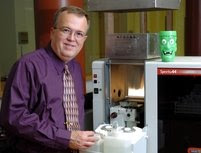Read the article (taken from a blog) below to know more about Professor Weidenhamer's crusade and how the CPSC functions --
When the Consumer Product Safety Commission recently recalled a lead-laden key-chain sold at Wal-Mart for three years, Ashland University Professor Jeffrey Weidenhamer was pleased but puzzled. Pleased that the CPSC had acted to remove the key chain from the market but puzzled that it had taken them so long to do so. After all, Weidenhamer had found high lead levels in a similar key chain when he tested it in 2006 and reported his results to the CPSC that December. What prompted the April recall was not Weidenhamer's testing but reports that a nine-month-old child who had mouthed one had elevated levels of lead in her blood.
"You shouldn't have to wait a year or 16 months to recall a product," Weidenhamer told a reporter for the Cleveland Plain Dealer.
Until recently, Weidenhamer’s research specialty had been chemical compounds produced by plants. Now he is more widely known for the research that he and his students at the Ohio college have done on lead in children’s toys. His findings may have resulted in at least 11 recalls by the Consumer Product Safety Commission involving more than 1.4 million individual items. That’s an impressive track record—although Weidenhamer is hesitant about touting it. As he wrote in Ashland's alumni magazine, “It is unfortunate that someone can become well known for drawing attention to lead contamination issues. It certainly would be far better for the kids if there were no story at all about lead contamination in these products.”
Weidenhamer’s fame all started with a chemistry class, Lead and Civilization, that he taught for non-majors and that focused on the chemistry and toxicity of lead. Then in the spring semester of 2006, he learned that a four-year-old Minnesota boy had died of lead poisoning after swallowing a lead-laden charm given away with a pair of shoes by Reebok International. (Earlier this year, Reebok agreed to pay a record $1 million penalty for distributing the charm bracelet).
Knowing that the analysis of metal samples for lead was not too involved, Weidenhamer thought his class would be able to conduct tests in the lab to see if similar items were on store shelves in his Ohio city. “I was not prepared for what my students found,” he said. “In the first set of 20 inexpensive jewelry items, 14 were heavily leaded, in two cases as high as 100 percent lead by weight.” CPSC guidelines for lead in children’s jewelry items sets a maximum level of 0.06 percent lead by weight.
Weidenhamer and his students have done repeated testing since the spring of 2006, including some tests of Halloween toys completed at the request of Ohio Senator Sherrod Brown. Weidenhamer says he tested more than 50 different items and found lead contamination in six of them, including plastic teeth. That, he says “seemed like the worst since they were clearly designed to go into a child’s mouth.” (The teeth were recalled by the CPSC.)
This spring, Weidenhamer found lead in several Easter products, two of which were recalled by the CPSC the Friday before Easter. “It is a surprise that after all the publicity about toy recalls of last year ... you can still find items on the shelves with lead in them.” He said he will continue to test products. “Hopefully by Halloween this year, we won’t be finding lead in paint in these products,” he said. “It shouldn’t be remotely possible for me or anyone to go out to American stores and pull products from shelves, test them and find levels of lead in them.”
Let's hope he's right but as long as it is possible, we are thankful for Weidenhamer’s efforts. And for that, he becomes one of our safety crusaders.
CPSC recalls related to complaints filed by Weidenhamer
- 86,400 children's "Ultra Gear" bracelets (DM Merchandising) Feb. 7, 2007
- 115,000 "Claudia Jublot" children's rings (Big Lots) Feb. 23, 2007
- 396,000 metal key chains (Dollar General) April 3, 2007
- 63,000 Frankenstein tumblers (Dollar General) Oct. 4, 2007
- 55,000 Halloween skull pails (Albert’s) Oct. 17, 2007
- 142,000 purple Halloween pails with witch decorations (Family Dollar Store) Oct. 25, 2007
- 43,000 “Ugly teeth” party favors (Amscan Inc.) Oct. 31, 2007
- 10,000 Halloween-themed baskets (Hobby Lobby) Nov. 16, 2007
- 205,000 pieces assorted Rachel Rose jewelry (Family Dollar Store) Nov. 21, 2007
- 13,000 camouflage eggs and spinning egg top toys (Hobby Lobby) Mar. 21, 2008
- 310,000 seasonal writing pads (Michaels Stores)

No comments:
Post a Comment